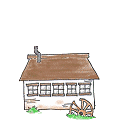posted 6 years ago
This seems like a good thread with good info, so I'll just add in here that my worm humanure setup is one of the most amazing things I've ever done. I've schlepped my way through handling sewage for 30 years, from RV tanks (ugh) to septic tanks, composting toilets of several styles....and the worms handling it is beyond wonderful!
The main advantage is that there are flush toilets in the house, which makes everyone happy in the long run, especially visitors.
A funny aside, I noticed we always had Daddy Long Legs spiders in the house, up in the corners of the ceilings, couldn't figure out how they got in. Just assumed it was because we were in a rural location. Also lots of ladybugs got in. After all of the compost potty weeds stopped coming inside, no more spiders/lady bugs inside.
One observation about composting toilet height vs. flush toilet height, never realized this, but the low seat level of the flush toilet is conducive to making everything work nicely. The composting toilets are very high, often with legs dangling straight down, which is not conducive to things working well. There's actually something called a Squatty Potty that is said to be a preferred style. So another plus for the flush toilet.
It's a pretty simple system, like the typical box arrangement pictured in this thread. The ground does not freeze here, so I can't vouch for keeping the setup from freezing. I know some friends in Canada have this method in a cesspit so the worms can go down below the frostline in the winter and survive. Cesspits might take some special care not to pollute ground water or provide too much fertilizer for large trees that might grow shallow roots and fall over in a big wind storm. Had friends who had this happen, not because of a septic setup, but because of grey water discharge, too much water on native trees.
Kept an eye on the gravel at the exit end for the first month to make sure it was draining properly and the worms were not drowning.
Here are some specifics:
1. No special worms, just worms found in my soil. They do a great job, multiply like crazy. Started with about 100 worms, and in just a couple spring/summer months they were everywhere in the box, and much bigger/healthier looking than when I put them in.
2. Lined the sides of the box with native soil so the worms could recognize the environment.
3. I use 1 1/2" rock at the outflow end of the box, wrapped in a large rectangle of chickenwire, folded over several times to make it strong, to block the end, but allow water to escape. I am not a woodchip fan, because they break down and get into the waterline and plug it up. Rocks worked well in my greywater reed beds, are easy to take out and rinse off and return if necessary.
4. The water from the washing machine does not go through this box, because it seems like a lot of water in a day (sometimes 4 loads) that might cause issues with the worms and draining too slowly, or flushing the vermicompost out too vigorously, so we rerouted that water to come in farther down the line.
5. The original setup of the interior of the box was to line the sides with native soil, then fill the middle third of the box with shredded paper, shredded egg cartons, about half the depth of the container. All torn/shredded paper can be thrown in here.
6. Added a smaller box downhill/downstream from the first main box that catches any worms that sneak out, and compost that washes out. This is an experiment just in case using the compost in the landscape was possible, and to make sure the worms were collected and moved/managed easily without having to go into the main box.
Six months later, the box contents looks like vermicompost, no odor, the worms are everywhere. The contents stays at a level of about half full. Not a lot of vermicompost gets collected in the second box. I just can't say enough how impressive this is, and would highly recommend it over a plain composting toilet.
Mediterranean climate, hugel trenches, fabulous clay soil high in nutrients, self-watering containers with hugel layers, keyhole composting with low hugel raised beds, thick Back to Eden Wood chips mulch (distinguished from Bark chips), using as many native plants as possible....all drought tolerant.

 2
2








 2
2









 2
2




 2
2














